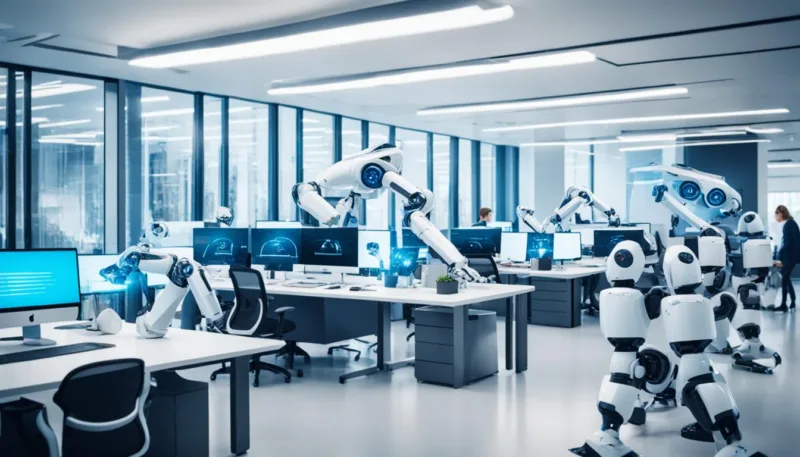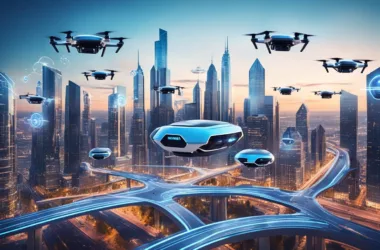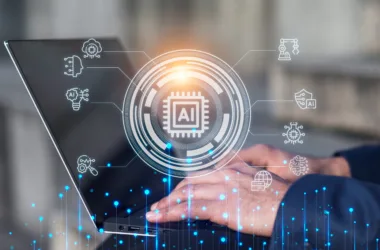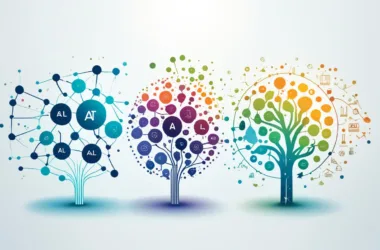AI is changing the way we think about work. Some people worry it might take away jobs. Others believe it will help us do our work better and open up new chances. Experts and big names in tech are looking into how AI will change our work life. They’re excited about new jobs and better ways of doing things, from office work to creative thinking.
Imagine AI not just changing jobs but also making new ones. What if automation in business actually makes us more productive and gets better results? Let’s dive into how AI in the workplace is set to change the work scene in amazing ways.
Key Takeaways:
- AI has the potential to enhance productivity and create new opportunities in the job market.
- Role reversal is predicted, where humans will assist machines instead of the other way around.
- AI technology can impact various industries, including healthcare, education, infrastructure, and professional services.
- Efficiency gains can be achieved in white-collar job functions, such as coding, financial services, and legal professions.
- The adoption of AI may reduce the demand for junior and mid-level software developers.
Role Reversal: Humans Assisting Machines
In the next decade, experts see a big change coming with AI technology. Instead of machines taking over jobs, people will help machines work better. This new way of thinking changes our usual ideas about machines doing all the work and opens doors for teamwork between humans and AI.
Humans and machines can do more together, reaching new highs in productivity. As AI gets smarter, humans will guide and add to its abilities. This ensures that AI makes choices with understanding and care.
Working with AI means we need new skills. Machines are great with data, but humans bring creativity and emotion. Together, human and AI smarts can create new solutions and make things better in many fields.
Enhancing Productivity through Collaboration
When people help machines, we can do more at work. This teamwork uses the special talents of both humans and AI technology.
In healthcare, AI helps doctors diagnose faster and more accurately. The AI looks at a lot of patient info, but the doctor uses their knowledge to understand and make choices.
This teamwork is also great in fields like manufacturing and customer service. Workers can be creative and solve problems, while machines handle the routine tasks.
Developing New Skill Sets for the Future
As people start helping machines, we need to learn new skills. It’s important to have abilities that make AI even better.
Skills like understanding data, thinking critically, and being emotionally smart will be more important. People must also be ready to learn new tech and work with AI tools.
Learning new things and upgrading skills makes workers fit for future jobs. Being proactive about skills makes people more employable and helps them succeed in an AI-driven world.
Let’s look at how this shift changes things:
| Traditional View of Automation | New Paradigm: Humans Assisting Machines |
|---|---|
| Humans do boring tasks and don’t get much better at them. | People and AI work together, using their special talents. |
| AI makes decisions without humans. | AI helps humans make better decisions with more information and support. |
| People worry about losing jobs to AI. | The focus is on doing better work and creating new jobs. |
| Skills become outdated because of machines. | New skills come up that make AI work even better. |
As work changes, humans helping machines opens up great chances for better work and new kinds of jobs. By working together, people and AI can make the future of work rewarding and efficient.
Impact Across Industries
Artificial Intelligence (AI) is changing many industries by bringing in automation, optimization, and personal touch. It’s making big changes in healthcare, education, infrastructure, and services. AI is leading to big advancements in these areas.
1. Healthcare
In healthcare, AI is a big help. It can do tasks, help with diagnostics, and make treatment decisions better. AI uses algorithms to look at medical records and images. This helps to find the best treatment plans for patients.
Thanks to AI, healthcare workers can use technology to work better, lower costs, and improve care for patients.
2. Education
AI is also changing education by making learning more personal and improving how instruction is done. It can adjust to how each student learns, give feedback, and point out what needs more work. Plus, AI can do a lot of admin work.
This lets teachers focus more on engaging with students and teaching in a way that meets their needs.
3. Infrastructure
The infrastructure industry gets a lot from AI too. It can automate tasks, make things run better, and help predict when things might break down. AI looks at a lot of data to help with things like saving energy and making better designs.
By using AI, organizations can use resources better, have less downtime, and make their projects more efficient and green.
4. Professional Services
AI is changing professional services by doing repetitive tasks for us, making things more accurate, and helping with making choices based on data. In legal work, AI can go through lots of documents quickly. This makes research and contract reviews faster.
AI also helps in finance by making risk assessments, spotting fraud, and optimizing portfolios easier.
AI is really shaking things up in various industries by making processes automatic, experiences personal, and operations optimized. Using AI in different sectors can lead to better results, more efficiency, and change how these industries work.
Comparison of AI Impact Across Industries
| Industry | AI Applications | Benefits |
|---|---|---|
| Healthcare | Automating administrative tasks, diagnostics, personalized treatment plans | Improved patient care, streamlined operations, reduced costs |
| Education | Personalized learning, adaptive tutoring, automated administrative tasks | Enhanced student engagement, optimized instruction, time savings for educators |
| Infrastructure | Infrastructure failure prediction, energy optimization, enhanced engineering designs | Optimized resource allocation, minimized downtime, improved sustainability |
| Professional Services | Automated legal research, contract review, risk assessment, fraud detection | Time savings, improved accuracy, data-driven decision-making |
A visual representation of the impact of AI across industries is provided in the table above.
Efficiency Gains in White-collar Job Functions
Artificial Intelligence (AI) is making a big impact on white-collar jobs. It’s helping industries like coding, finance, and law work smarter.
- Coding: AI changes how we develop software. It means less need for developers. These AI systems can write code, do the boring tasks, and find smart solutions quickly.
- Financial Services: In finance, AI is a game-changer. It’s great at analyzing data, handling day-to-day tasks, and assessing risks. All this lets experts focus on the big picture, like improving investment strategies and catching fraud.
- Legal: AI tools are also updating the legal world. They make searching through laws and checking contracts faster. This gives legal pros more time for the tough cases and working with clients.
This change in white-collar jobs is huge. Using AI, people can do their jobs better than ever. It’s all about being more productive and efficient.
AI isn’t about taking jobs from people. It’s here to make their work better. AI helps with the hard stuff, so they can do what humans are best at: thinking creatively and solving problems.
Reducing the Need for Junior and Mid-level Developers
Large language models are changing how we develop software. This shift means companies need fewer junior and mid-level developers. Startups now use AI to help write code more efficiently. Yet, they still rely on their chief technology officers (CTOs) and AI leaders. This shows that AI can change jobs and underscores the need for pros to learn new skills.
Though these models may lessen some jobs, they offer chances to work with AI in new ways. Developers must learn advanced coding and understand AI to stay relevant. The industry’s shift demands that developers enhance their skills.
Benefits and Challenges
Using large language models in software development has its ups and downs:
- Efficiency: AI co-pilots make coding faster and more streamlined.
- Productivity: They automate boring tasks, so developers can do more important work.
- Skills Adaptation: People need to deeply understand AI and keep their coding skills sharp.
- Job Role Evolution: Software developers are moving towards more creative tasks because of AI help.
- Knowledge Expansion: Developers can grow their skills by adding AI knowledge to their coding expertise.
Despite these benefits, there are hurdles to overcome:
- Job Market Impact: The shift might force people to learn new skills to keep up with job needs.
- Collaboration: It’s essential to learn how to work with AI systems effectively.
- Technological Advancement: Staying up-to-date with AI developments is critical to remain relevant.
AI-Powered Peer-to-peer Learning
The world is quickly taking up AI technology, sparking big changes in learning and skill development. AI, particularly GenAI, is set to change how we learn at work and beyond.
These smart AI systems can make learning personal and hands-on, changing the usual way we think about careers. They blend the power of AI with learning from peers, helping everyone grow continuously.
Just like social media changed how we share stories, AI learning platforms are changing how we learn new things. They let learners find endless resources and connect with others who have the same goals.
These platforms use AI to understand what each learner is good at and what they need to work on. They offer customized advice and learning plans. This means learners can work on their weak spots more effectively.
AI learning sites offer a space for learners to share knowledge, work together, and use their group’s wisdom. By working together, learners can better understand tough topics and learn from real-life stories.
With AI learning, careers don’t have to follow a straight line. People can explore different areas, learn various skills, and build their own success paths.
Using AI tech for learning lets us go beyond old limits, expanding what we can know. Peer learning builds community and sparks idea sharing, driving endless growth in today’s changing job world.
Benefits of AI-powered Peer-to-peer learning:
- Enhanced Learning Experience: AI sorts out what each person needs to learn, offering custom tips and plans.
- Collaborative Learning Environment: Learners can work with others, tackle projects together, and use the group’s knowledge.
- Interdisciplinary Skill Development: AI sites let people dive into many fields, gaining a broad set of skills.
- Continuous Upskilling: Peer learning encourages a lifelong learning mindset, crucial for thriving in a changing work scene.
GenAI-driven peer learning opens new doors in an AI future, letting people continuously learn and carve out fulfilling careers.
Transforming Decision-making Processes
Artificial intelligence (AI) is changing how companies make choices. Thanks to AI, decision-making is getting faster, smarter, and more independent. It’s creating new chances for optimization, autonomy, and smart simulations.
AI’s role in decision-making is huge, mainly through simulations. These simulations let businesses test out various scenarios and see possible results. They help companies with pricing, improving transport and logistics, and solving design issues without much manual work.
AI is also changing commercial decisions. It uses optimization algorithms to pinpoint the best strategies. These algorithms sift through huge data sets to improve outcomes. This helps businesses use their resources well and get better results.
Sometimes, AI can completely take over complex decisions. It uses machine learning to analyze data and recognize patterns on its own. This quick and efficient process reduces human mistakes and biases.
Examples of AI in Decision-making Processes
AI is already influencing decisions in many fields. Here are some examples:
- Analyzing market data and customer habits, AI helps set the best prices.
- AI examines real-time data and traffic to improve delivery routes.
- It generates and assesses design options, aiding engineers and designers.
AI’s growth could lead to digital business models. With advanced AI, companies can make decisions without humans. This will greatly improve how they operate.
Using AI to make decisions brings big benefits. It ups efficiency, accuracy, and complex data analysis. Yet, it’s important to keep a balance. AI should support, not replace, human decision-making.
The next part will talk about how defensibility and distribution matter for successful AI businesses.
Defensibility and Distribution in AI Businesses
To build a successful AI business, founders need to focus on two things: defensibility and getting their product to customers. True, having an easy-to-use product and unique data is important. But these alone won’t ensure long-term success in AI. Founders must create business models that encourage users to interact and share data. This creates a network effect, adding a lot of value.
Defensibility means making it hard for others to compete with you. This can be done by protecting your ideas, being a brand people know, and working closely with others. Such a strong position helps AI businesses protect their innovations. It also helps them stand out and maintain an advantage.
Getting the product to users is equally important for AI companies. No matter how great the technology is, it won’t succeed if people don’t use it. It’s crucial to figure out how to make sure many people adopt your AI solutions. This could mean working with big names, using your existing customers, or running specific marketing efforts.
Using your own data can really help get your product out there and create value. AI companies can train their models and offer custom solutions with their unique datasets. This can set companies apart, allowing for better results, more accuracy, and tailored services.
In conclusion, AI business founders should make defensibility and distribution their top priorities. They have to look beyond just having a user-friendly product and unique data. They need to encourage user engagement and data sharing to create a network effect. By doing so, AI businesses can secure a strong market position, reach more people, and create lasting value.
Defensibility and Distribution Strategies in AI Businesses
| Defensibility Strategies | Distribution Strategies |
|---|---|
| Intellectual property protection | Strategic partnerships |
| Strong brand recognition | Effective go-to-market strategies |
| Proprietary data | Industry leader collaborations |
Sustainable Business Models in Generative AI
Generative AI is changing how businesses work, offering big chances to improve productivity and cut costs. But, the complexity of AI models can slow down their use. To overcome this, new business models that focus on AI infrastructure and research are taking shape.
These models focus on strong infrastructure and cutting-edge research. This lets companies use generative AI in sustainable ways. It changes how work is done, helping both bosses and workers.
Generative AI is great because it can make businesses more productive. It does this by doing repetitive tasks and giving smart insights. This helps businesses be more efficient and gain an edge over others.
Cost optimization is also key. Yes, starting with AI can be pricey. But, sustainable AI business models work to keep costs down. They find smart ways to save money and use resources wisely. This helps businesses stay strong and financially healthy in the long run.
Building a strong AI infrastructure is essential. Investing in the latest technology, cloud services, and data systems is a must. This infrastructure supports AI apps and makes them work well with current processes.
Benefits of Sustainable Business Models in Generative AI:
- Improved productivity through automation and intelligent insights.
- Cost structure optimization for long-term viability and financial stability.
- Scalable infrastructure for seamless integration and smooth operation of AI-powered applications.
- Enhanced research and development to stay at the forefront of generative AI innovation.
Research is crucial in these business models. It helps companies stay competitive and improve their AI tools. By focusing on advancement, they can keep up with AI changes and innovate.
Adopting sustainable models in AI leads to better productivity and cost savings. It’s about focusing on infrastructure, research, and being smart with resources. This approach helps businesses make the most of AI and change how work is done.
For sustainable AI models to work, understanding the tech and its impact is necessary. Cooperation among leaders, researchers, and policymakers helps support AI development and use. With the right strategy, businesses can fully benefit from AI, creating a more productive future.
Navigating the Noise: Identifying Substance in AI Innovations
AI innovations can change industries and lead to big advancements. Yet, with so much new tech appearing quickly, it’s hard to know what’s truly revolutionary. We need to find the real gems among the buzz.
Looking at disruptor trends is important. These trends are new technologies that could change the AI field completely. By keeping up with these trends, companies can find exciting innovations. They avoid spending on things that won’t last.
Automation is key in AI. It handles repetitive tasks, freeing up time and resources. This lets workers do more important, creative work. Automation also makes things more efficient, accurate, and speedy worldwide.
Exploring hybrid solutions is worthwhile too. These mix human skills with AI tech, leading to strong results. By combining human insight and AI’s power, companies can make the most of AI. They achieve lasting growth this way.
The Importance of Identifying Substance
Finding what truly matters in AI is vital for a few reasons. It guides businesses in using their resources effectively. They invest in tech that brings real value. Plus, it stops them from missing out on major advancements.
Strategies for Identifying Substance
Here are strategies for finding what’s substantial in AI:
- Keep up with the latest research: By following top AI institutes, reading studies, and going to conferences, companies can learn about new tech.
- Connect with the AI world: Joining forums and groups helps businesses meet experts. Sharing knowledge can reveal impactful solutions.
- Find expert advisors: Working with experienced consultants gives businesses special insights. These advisors can help judge AI ideas clearly.
- Look at real uses: Seeing how AI can fit into current processes is crucial. It should offer clear benefits.
- Try pilot projects: Testing AI in real settings gives concrete proof of its value. This experience can guide decisions.
The Future of AI Innovations
The AI field keeps growing, with breakthroughs happening all the time. Companies must stay active to spot valuable opportunities. By following new trends, using automation, and trying hybrid approaches, they can fully use AI. This prepares them for the future.
The Gradual and Sudden Impact of Technology on Work
Technology changes, like AI, affect jobs slowly at first, then quickly. Job roles change over time. Changes come in steps, like offshoring. But with AI improving and changing how business works, we see quick changes in what jobs need. This has happened in back-office work and in software development, where AI is making a big difference.
Technological change always leads to new kinds of jobs. With AI growing fast, this change might happen quicker, changing jobs in ways we can’t predict. AI can do tasks once done by people, automating them. This could result in lost jobs or a need for new skills. Back-office work, full of repeat tasks, is especially at risk of being automated.
In software development, AI is changing how we create and take care of apps. AI tools help automate coding, check code quality, and find bugs better. This lets developers focus on solving bigger problems instead of doing repeat tasks. It leads to more productivity and new ideas.
Changing Dynamics in Back-Office Work
Back-office work includes many admin tasks that keep a company running. This includes data entry, keeping records, handling invoices, and customer support. With AI’s help, many of these tasks can be automated. This means fewer people are needed for routine work.
Companies use AI to make back-office work better, faster, and cheaper. Chatbots with the ability to understand and use human language can take over customer questions. This lets people work on harder problems. Also, AI can look through lots of data, find important information, and do data entry tasks by itself.
Automating back-office tasks brings benefits and challenges. It makes things more efficient and reduces mistakes. But it also means some jobs will change. Companies need to help their workers learn new skills for new types of work that can’t be automated.
The Transformative Potential of AI in Software Development
AI is changing jobs in software development a lot. Tools powered by AI, like code generators and test platforms, change how we develop software. These tools can create code, suggest code improvements, and find bugs. This saves developers time and work.
AI systems analyze lots of code and learn from it. This means they can offer better advice and spot issues early. It leads to better code and more reliable apps.
AI tools also help development teams work better together. They automate code reviews, help manage different versions of code, and give feedback in real-time. This makes developing software faster and improves the quality of the code. It helps get software solutions ready quicker.
| Benefits of AI in Software Development |
|---|
| 1. Increased productivity and efficiency |
| 2. Enhanced code quality and reliability |
| 3. Streamlined collaboration and communication |
| 4. Faster time to market for software products |
| 5. Opportunities for developers to focus on higher-level problem-solving |
While AI in software development has many benefits, human skills and creativity are still key. AI tools are meant to support and increase human abilities, not replace them.
The slow mix of AI into jobs shows how job roles change with new technology. Companies and people must keep learning and adapting. By using AI, workers can do more valuable tasks, drive innovation, and shape the future of work.
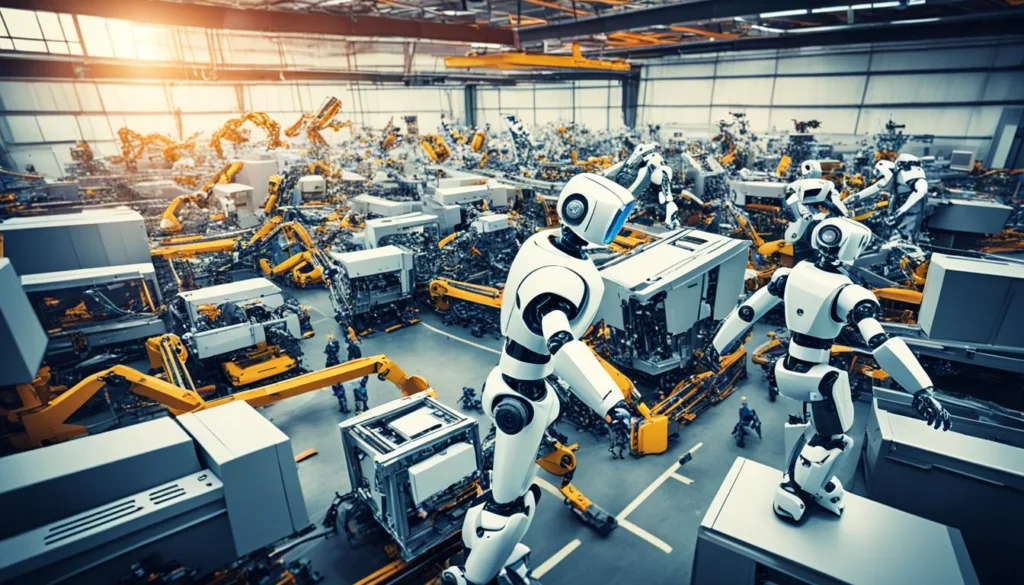
Conclusion
AI’s role in changing jobs and how we work is profound. It can boost efficiency and offer new job types. Yet, it poses risks like job loss and growing inequality. To tackle these, leaders must design strong social protections, training, and open policies.
Getting ready for AI is key to shaping work’s future. Nations should embrace AI and set smart rules to stay ahead. This means investing in infrastructure, training people, and encouraging innovation.
As we delve deeper into the AI era, finding the right balance is crucial. We should use AI to support humans, drive economic growth, and cut down inequality. This way, AI can enhance our skills, create wealth, and make society more equal.


